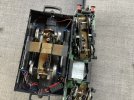DafyddElvy
1:22.5 & 15mm Scale Trams, , NG Steam Railways
A question that came to mind relating to 7mm scale modelling but equally applicable in our scale.
While I appreciate their are a lot of variables when it comes to motorising our model trams, is anyone aware of an optimum weight to power ratio for a 4 wheel car?
A friend and I are at the very stages of planning a new layout which will have one particularly steep grade with a curve at the top of the gradient, and we are looking for guidance on the maximum weight to make our models which will predominantly be 4 wheel with both axles powered, any suggestions appreciated, thanks.
While I appreciate their are a lot of variables when it comes to motorising our model trams, is anyone aware of an optimum weight to power ratio for a 4 wheel car?
A friend and I are at the very stages of planning a new layout which will have one particularly steep grade with a curve at the top of the gradient, and we are looking for guidance on the maximum weight to make our models which will predominantly be 4 wheel with both axles powered, any suggestions appreciated, thanks.

